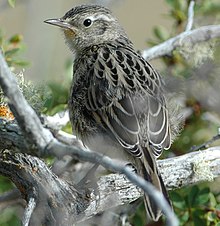Austral canastero
| Austral canastero | |
|---|---|

| |
| Scientific classification | |
| Domain: | Eukaryota |
| Kingdom: | Animalia |
| Phylum: | Chordata |
| Class: | Aves |
| Order: | Passeriformes |
| Family: | Furnariidae |
| Genus: | Asthenes |
| Species: | A. anthoides
|
| Binomial name | |
| Asthenes anthoides (King, 1831)
| |

| |
The austral canastero (Asthenes anthoides) is a species of
Taxonomy and systematics
Before the middle of the twentieth century, the austral canastero was bounced around several genera but since then has almost universally been placed in Asthenes.
The austral canastero's English name refers to its southern distribution and its
Description
The austral canastero is 15.5 to 16.5 cm (6.1 to 6.5 in) long and weighs 21 to 23 g (0.74 to 0.81 oz). It is the southernmost canastero, and one of several streaked canasteros that have drab plumages with dark stripes on their upperparts. It has a shorter tail than many other canasteros. The sexes have the same plumage, but there is much individual variation. Adults have a whitish or pale buff
Distribution and habitat
The austral canastero has a
Behavior
Movement
The northern population of the austral canastero is at least partially migratory. Birds on both sides of the southern Andes mostly migrate north into central Chile after breeding; they are more numerous then near the coast but are also found inland. The southern population apparently resides year-round in southern Patagonia and on Tierra del Fuego.[3]
Feeding
The austral canastero feeds on arthropods. It forages singly or in pairs, gleaning prey from the ground and shrubs, and sometimes pushes into grass clumps to forage.[3]
Breeding
The austral canastero breeds in southern Chile and Argentina during the austral spring and summer, roughly between October and February, but its season elsewhere is not known. It is thought to be monogamous. It makes a globular nest of thorny sticks with a side entrance and lines the interior with soft plant material. It is typically placed inside or under a shrub. The clutch size is two eggs. The incubation period, time to fledging, and details of parental care are not known.[3]
Vocalization
The austral canastero's song is a "short rising trill repeated several times with intervals of a few seconds". It mostly sings during the breeding season, during the morning and late afternoon, and from atop a small bush. Its call is a " very short metallic tick, repeated in loose series".[3]
Status
The
References
- ^ . Retrieved 24 September 2023.
- ^ Rasmussen, Pamela, eds. (July 2023). "Ovenbirds, woodcreepers". IOC World Bird List. v 13.2. Retrieved July 31, 2023.
- ^ a b c d e f g h i Pantoja, V., J. V. Remsen, Jr., and P. F. D. Boesman (2021). Austral Canastero (Asthenes anthoides), version 2.0. In Birds of the World (T. S. Schulenberg and B. K. Keeney, Editors). Cornell Lab of Ornithology, Ithaca, NY, USA. https://doi.org/10.2173/bow.auscan1.02 retrieved September 24, 2023
- ^ Derryberry, E. P., S. Claramunt, G. Derryberry, R. T. Chesser, J. Cracraft, A. Aleixo, J. Pérez-Emán, J. V. Remsen, Jr., and R. T. Brumfield. (2011). Lineage diversification and morphological evolution in a large-scale continental radiation: the Neotropical ovenbirds and woodcreepers (Aves: Furnariidae). Evolution 65(10):2973–2986. https://doi.org/10.1111/j.1558-5646.2011.01374.x
- ^ ISBN 0691090351.
External links
- Austral canastero photo gallery VIREO
- Photo-High Res & Article; Photo-Medium Res avesdechile


